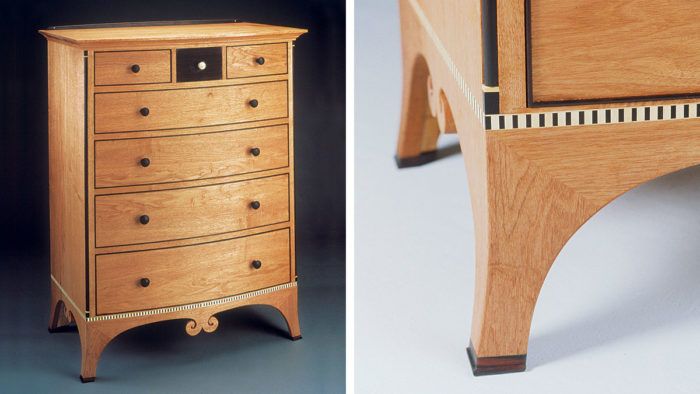Designing a Chest of Drawers
Borrow form and detail from the past to help develop new ideas
Synopsis: Garrett Hack shows how to gather a fresh and intriguing design from combinations of ideas you’ve picked up over the years. He offers tips on selecting wood, proportioning drawers, making cove molding, building French feet, and how fancy details have practical applications. His apron accents and holly columns, as well as other design elements, unify the chest of drawers that is the focus of this article.
The chest form has been around at least 3,000 years, so it’s hard to imagine designing something original today. I don’t even pretend to. Instead, I freely borrow from this wealth of past ideas. Generations of craftsmen before me have played with chests in every way imaginable. They have refined everything from the sensuous sweep of certain curves to the basics of drawer joinery and case construction. Chests of drawers—from simple country chests to sophisticated highboys—are rich with ideas and lessons.
For me, originality comes not from trying to invent some new form or detail, but from some fresh and intriguing combination of ideas I’ve picked up along the way. I’ve been building and studying chests for years, and I’ve learned that knowledge builds on knowledge; you have to learn certain basics—about both design and construction—before you can understand more complex ideas. I can look at all sorts of furniture and absorb ideas, but only by actually building a piece that incorporates those ideas do they become part of my design vocabulary. And more importantly, I begin to understand new directions in which I can push those ideas next time. When thinking about a design problem, I often start by evaluating similar (and dissimilar) pieces I’ve built in the past.
The most exciting designs are those with the fewest restrictions. For example, a man recently gave me a commission for a chest of drawers. He didn’t have any fixed ideas of what he wanted. He favored cherry, but he was open to other light-colored native woods. He also liked the dimensions of another chest he owned, about 4 ft. high and a little less than 3 ft. wide.
Find a starting point
Designing a chest of drawers shouldn’t be all that complicated, considering that it’s basically a series of boxes that slide into a larger box. Thinking about wood choices is often a good place to begin the design process. Dark woods can make a large chest seem heavier, just as light woods have the opposite effect. Chests have a lot of surfaces—the sides, top and drawers—that show off a wood differently than, say, the linear parts of a chair. Lots of heavy grain can dominate and distract from the quieter details. Fine-grained hardwoods take and hold small details that time would deface in a softer wood like white pine. With its quiet grain and rich color, cherry would have been a good choice for the client’s chest of drawers, but I was a little tired of seeing it everywhere.
From Fine Woodworking #151
For the full article, download the PDF below:
Fine Woodworking Recommended Products

Compass

Stanley Powerlock 16-ft. tape measure

Dividers























Log in or create an account to post a comment.
Sign up Log in